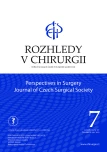-
Medical journals
- Career
Diagnosis and treatment of surgical skin and soft tissue infections – current status
Authors: J. Ulrych 1; V. Adámková 2; R. Gürlich 3; M. Kolář 4; H. Lahoda-Brodská 5; V. Třeška 6; L. Veverková 7
Authors‘ workplace: I. chirurgická klinika – hrudní, břišní a úrazové chirurgie, Všeobecná fakultní nemocnice a 1. lékařská fakulta, Univerzity Karlovy v Praze 1; Klinická mikrobiologie a ATB centrum, Ústav lékařské biochemie a laboratorní diagnostiky VFN, Praha 2; Chirurgická klinika Fakultní nemocnice Královské Vinohrady a 3. lékařské fakulty Univerzity Karlovy v Praze 3; Ústav lékařské mikrobiologie Lékařské fakulty Univerzity Palackého Olomouc 4; Ústav lékařské biochemie a laboratorní diagnostiky Všeobecné fakultní nemocnice, Praha 5; Chirurgická klinika Fakultní nemocnice Plzeň a Lékařská fakulta Univerzity Karlovy, Plzeň 6; I. chirurgická klinika Fakultní nemocnice u sv. Anny a Lékařská fakulta Masarykovy univerzity Brno 7
Published in: Rozhl. Chir., 2022, roč. 101, č. 7, s. 300-311.
Category: Review
doi: https://doi.org/10.33699/PIS.2022.101.7.300–311Overview
Surgical skin and soft tissue infections (SSTIs) result from microbial invasion of the skin and underlying soft tissues, often requiring surgical treatment. SSTIs encompass a variety of pathological conditions, ranging from frequent simple superficial skin infections with very good outcomes to rare, rapidly progressive necrotizing infections associated with long-lasting morbidity and high mortality. The document summarizes current knowledge of the diagnosis and therapy of these diseases and provides clinicians with current standards of care of these patients based on international guidelines. Additionally, regional specific aspects are also reflected, and thus in all cases, this paper on diagnostic-therapeutic management of individual clinical forms respects the actual clinical practice and epidemiology in the Czech Republic. The document has been prepared based on multidisciplinary consensus of experts from universities all over the Czech Republic.
Keywords:
diagnosis – treatment – skin and soft tissue infections – SSTI
Sources
1. https://www.uzis.cz/res/f/008357/hospit2019. pdf/str.45
2. Sartelli M, Malangoni MA, May AK, et al. World Society of Emergency Surgery (WSES) guidelines for management of skin and soft tissue infections. World J Emerg Surg. 2014;9(1):57. doi:10.1186/1749-7922-9-57.
3. Jenkins TC, Knepper BC, Jason Moore S, et al. Microbiology and initial antibiotic therapy for injection drug users and non-injection drug users with cutaneous abscesses in the era of community - associated methicillin-resistant Staphylococcus aureus. Acad Emerg Med. 2015;22(8):993–997. doi:10.1111/ acem.12727.
4. Moet GJ, Jones RN, Biedenbach DJ, et al. Contemporary causes of skin and soft tissue infections in North America, Latin America, and Europe: report from the SENTRY Antimicrobial Surveillance Program (1998–2004). Diagn Microbiol Infect Dis. 2007;57(1):7–13. doi:10.1016/j. diagmicrobio.2006.05.009.
5. Tiemersma EW, Bronzwaer SL, Lyytikäinen O, et al. European Antimicrobial Resistance Surveillance Systém Participants. Methicillin-resistant Staphylococcus aureus in Europe, 1999–2002. Emerg Infect Dis. 2004;10(9):1627–34. doi:10.3201/ eid1009.040069.
6. https://www.ecdc.europa.eu/sites/default/ files/documents/Country%20summaries - AER-EARS-Net%20202019.pdf
7. Sartelli M, Guirao X, Hardcastle TC, et al. 2018 WSES/SIS-E konsensus conference: recommendations for the management of skin and soft-tissue infections. World J Emerg Surg. 2018;13 : 58. doi:10.1186/ s13017-018-0219-9.
8. Stevens DL, Bisno AL, Chambers HF, et al. Practice guidelines for the diagnosis and management of skin and soft tissue infections: 2014 update by the Infectious Diseases Society of America. Clin Infect Dis. 2014;59(2):e10–52. doi:10.1093/cid/ ciu444.
9. Sartelli M, Coccolini F, Kluger Y, et al. WSES/ GAIS/WSIS/SIS-E/AAST global clinical pathways for patiens with skin and soft tissue infections. World J Emerg Surg. 2022;17(1):3. doi:10.1186/s13017-022-00406-2.
10. Lipsky BA, Aragón-Sánchez J, Diggle M, et al. IWGDF guidance on the diagnosis and management of foot infections in persons with diabetes. Diabetes Metab Res Rev. 2016;32 Suppl 1 : 45–74. doi:10.1002/ dmrr.2699.
11. Abrahamian FM, Goldstein EJ. Microbiology of animal bite wound infections. Clin Microbiol Rev. 2011;24(2):231–246. doi:10.1128/CMR.00041-10.
12. Tessier JM, Sanders J, Sartelli M, et al. Necrotizing soft tissue infections: A focused review of pathophysiology, diagnosis, optative management, antimicrobial therapy, and pediatrics. Surg Infect (Larchmt). 2020;21(2):81–93. doi:10.1089/sur.2019.219.
13. van Stigt SF, de Vries J, Bijker JB, et al. Review of 58 patients with necrotizing fasciitis in the Netherlands. World J Emerg Surg. 2016;11 : 21. doi:10.1186/s13017 - 016-0080-7.
14. Gatti M, Gasparini LE, Laratta M, et al. Intensive multidisciplinary management in critical care patiens affected by severe necrotizing soft tissue infections: a cooperative method to improve the efficacy of treatment. Eur J Clin Microbiol Infect Dis. 2019;38(6):1153–1162. doi:10.1007/ s10096-019-03521-2.
15. Levett D, Bennett MH, Millar I. Adjunctive hyperbaric oxygen for necrotizing fasciitis. Cochrane Database Syst Rev. 2015;1(1):CD007937. doi:10.1002/14651858.CD007937.pub2.
16. Hua C, Bosc R, Sbidian E, et al. Interventions for necrotizing soft tissue infections in adults. Cochrane Database Syst Rev. 2018;5(5):CD011680. doi:10.1002/14651858.CD011680.pub2.
17. Hakkarainen TW, Kopari NM, Pham TN, et al. Necrotizing soft tissue infections: review and current concepts in treatment, systems of care, and outcomes. Curr Probl Surg. 2014;51(8):344–362. doi:10.1067/j. cpsurg.2014.06.001.
Labels
Surgery Orthopaedics Trauma surgery
Article was published inPerspectives in Surgery

2022 Issue 7-
All articles in this issue
- Mikrobiologie v chirurgii
- Diagnosis and treatment of surgical skin and soft tissue infections – current status
- Microbiological analysis of peritoneal fluid samples from patients with perforated peptic ulcer – retrospective observational study
- Infections associated with vascular reconstruction procedures at the Department of Surgery in Pilsen in retrospect
- Laparoscopic repair of perforated peptic ulcer – routine procedure or targeted patient selection?
- Benign stenosis of common bile duct after Roux Y gastrectomy
- Giant aggressive intra-abdominal desmoid-type fibromatosis – case report
- Perspectives in Surgery
- Journal archive
- Current issue
- Online only
- About the journal
Most read in this issue- Diagnosis and treatment of surgical skin and soft tissue infections – current status
- Giant aggressive intra-abdominal desmoid-type fibromatosis – case report
- Laparoscopic repair of perforated peptic ulcer – routine procedure or targeted patient selection?
- Benign stenosis of common bile duct after Roux Y gastrectomy
Login#ADS_BOTTOM_SCRIPTS#Forgotten passwordEnter the email address that you registered with. We will send you instructions on how to set a new password.
- Career

